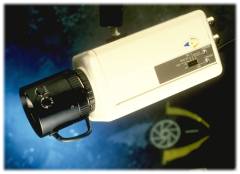>
Understanding Cameras
At the heart of the CCTV camera technology is a CCD sensor (Charge Coupled Device) that converts light into an electrical signal. This electrical signal is then processed by the camera electronics and converted to a video signal output that can then be either recorded or displayed on to a monitor. However, the treatment of the video signal is then dependant on the type of camera. CCD chip cameras can be divided into two principal types: analogue or the more recently introduced digital versions. These can be sub-divided further into the following:
To complicate matters even further, each of the above is generally available with different levels of performance -like a car model varying from 'base features' to 'top of the range'. Monochrome or Colour?The human eye remembers and recalls things better if they appear in colour - it's easier to track down a brown-haired person wearing a red sweater and blue jeans than a dark, grey-clad figure that would be produced in monochrome. Colour cameras carry an additional premium in price compared with monochrome cameras. But they are also less sensitive making night usage an impractical option unless good lighting is available. Monochrome cameras can offer Infra Red (IR) sensitivity allowing their use with covert IR illumination possible. This can be particularly useful where planning permission makes extra lighting impractical or the security requirement is such that intruders should not be alerted to the existence of CCTV surveillance. Analogue or Digital?Until recently most cameras have been of the analogue type, producing good quality images at an affordable price. However, the introduction of Digital Signal Processing (DSP) has increased both the flexibility of using security cameras whilst enhancing the quality of the colour images produced. At the heart of DSP lies computer microchips, or 'chip sets' which have replaced the conventional integrated circuits in the camera head. This enables DSP camera manufacturers to offer installer friendly, feature-rich products. The market for DSP technology falls into two broad categories: 'standard' and 'premium' DSP. Standard DSP cameras generally offer more consistent picture quality than their analogue counterparts, operating over a wider range of lighting conditions. Premium DSP cameras, however, have much richer functionality. This includes programmable intelligent backlight compensation (BLC), Video Motion Detection, remote set-up and control using a serial data link; built-in character generator and on-screen menus. These features make Premium DSP cameras the ideal choice for complex surveillance conditions such as those encountered in town centres. Some situations may require a standard DSP camera, but with a specific premium feature. A good example of this is the Vista NCL634 colour camera. Using digital signal processing, the NCL634 splits the screen into 64 zones. The DSP function calculates the average brightness within each of these zones and then compares it with those in all 64 zones. The camera can then adjust the picture detail for areas that are in silhouette. This innovative feature is ideal in awkward lighting situations, e.g. a camera looking towards a shop window. In the morning, the sun may be in the top left corner of the window, but then moves across the field of view during the day, causing poor picture quality in most cameras. Intelligent backlight compensation is a function that will ensure crisp detailed pictures automatically throughout the day. CCD Chip SizeCCTV cameras generally use COD chips that are designed for the consumer camcorder market. Originally, the chips used were half-inch image diagonal, but the drive for reduced size led to the development of third-inch and more recently quarter-inch chips. The half-inch chips are capable of producing the highest sensitivity and resolutions owing to the simple fact that they are able to gather more light. Third-inch chips now form an increasing part of the market and as product development continues their performance is approaching that of their larger brothers. Quarter-inch chip sets are a relatively recent development and are being widely used in consumer camcorders. Currently their use in CCTV is still somewhat limited because of the lack of availability and range of quarter-inch format lenses. As a general rule, quarter-inch cameras provide the lowest cost and performance while half-inch cameras provide premium performance and are more expensive. Mid-priced third-inch cameras make up the bulk of cameras used in the market today. Written by http://www.cctv-information.co.uk/ |
|
|
|||||||||||||||
| R.S.C. Broadband Supply Co. © 2006 • Privacy Policy • Terms Of Use | ||||||||||||||||




 Specification of the right CCTV camera for a project is not always the easiest of processes. There are many factors that have to be taken into account: technical specifications, the application and its requirements, as well as any physical constraints the site may impose. With ever increasing product ranges available in the marketplace, and technology constantly evolving to optimise performance, reliability and functionality, it is quite a challenge to make an informed decision to meet the requirements for the job whilst remaining within projected budget. Understanding the many variables within CCTV camera technology today can only be an advantage in helping you make the right choices.
Specification of the right CCTV camera for a project is not always the easiest of processes. There are many factors that have to be taken into account: technical specifications, the application and its requirements, as well as any physical constraints the site may impose. With ever increasing product ranges available in the marketplace, and technology constantly evolving to optimise performance, reliability and functionality, it is quite a challenge to make an informed decision to meet the requirements for the job whilst remaining within projected budget. Understanding the many variables within CCTV camera technology today can only be an advantage in helping you make the right choices.